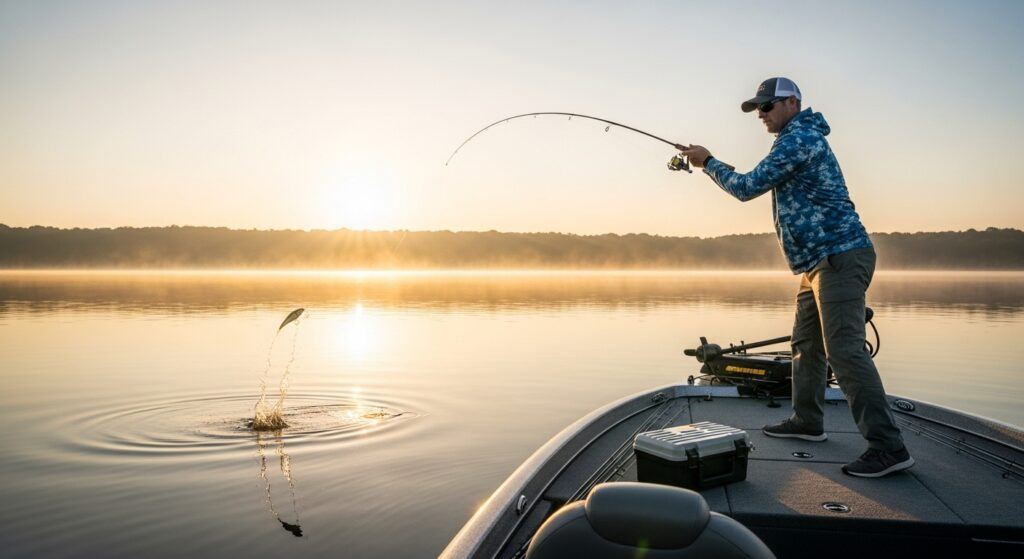If you’re planning to fish Lake Webster and want to try artificial lures, I’ll walk you through what I’ve learned about making them work in this big Indiana lake. Artificial lures can be confusing at first, with all the sizes and types, but once you get the basics, there’s a good chance you’ll see more bites. Lake Webster has a reputation for muskie, but there are also largemouth, crappie, bluegill, and even the odd northern pike, so there’s more variety than you might expect.

Why Artificial Lures Work So Well at Lake Webster
Artificial lures are popular here because live bait is often regulated and can be challenging to keep fresh. But even if bait was never an issue, the real reason might be how aggressive muskie and bass can be. They hit moving targets, and having a range of lures helps you adjust what you’re offering based on conditions or what you see working for others around you.
I’ve had days when crankbaits outperformed live shiners for muskie, especially if water clarity is good. Other times, I saw nothing biting until I tried a soft plastic jerkbait. Lake Webster’s structure changes a lot, too. Along the shoreline, you get weeds and stumps; in open water, mid-depth humps create perfect ambush spots. Lures let you cover each area at different speeds and depths, which is surprisingly helpful.
Getting Set Up: Basics for Fishing Lake Webster with Artificial Lures
If you don’t have much experience, it’s easy to get confused and leave with a packed tackle box but little idea what to tie on first. Here’s what I start with:
- Medium-Heavy Rod & Reel: This covers most Lake Webster targets. Heavier gear works well for muskies, but if you’re going after panfish or bass, a medium spinning combo feels right.
- Braided or Fluorocarbon Line: I know people have strong opinions on this topic. I like braid around heavy cover, but clear, abrasion-resistant fluoro works well for wary fish.
- Topwater, Diving, and Soft Plastic Lures: I generally bring a mix, since Webster’s fish move around with seasons, weather, and sunlight. You really can’t go wrong with shad-pattern crankbaits, soft plastics in natural colors, and a few big, flashy topwater plugs if chasing muskie or pike.
- Leader Material: Wire leaders are good for muskie, but crappie and bass spook easily, so a light fluoro leader comes in handy.
The main thing is versatility. You can always bring extras, but for a first trip, those are what I’d call the basics.
Best Times and Conditions to Use Artificial Lures at Lake Webster
The weather here impacts which lures work. On bright, sunny mornings, fish sometimes stay deeper or push under docks and into weeds. For me, that’s when soft plastics or slow-rolled spinnerbaits do well. Overcast skies or after a rain, fish tend to be less cautious, and you get more aggressive strikes—brighter colors or noisy lures can turn slow days around.
I like late spring and early fall for consistent action. Water temperatures aren’t too warm or cold, baitfish are active, and fish seem to hit artificials more often. Early morning or late evening, when the water’s calm, is prime for topwater lures. Even on a hot summer day, muskie sometimes bite during midday if the wind stirs up the water or clouds roll in.
Types of Artificial Lures for Lake Webster: What’s Actually Worth Tying On?
People get into debates about the “best” lures at Webster. I honestly think it changes from week to week, but there are definitely a few types that tend to perform better:
- Crankbaits: I keep a few shad or perch patterns in the box. They dive to different depths, and you can cover a ton of water quickly. Squarebills bounce over rocks near shore, while deep divers can get down near stump fields in summer.
- Spinnerbaits: These work well around weeds and wood. White or chartreuse colors seem reliable for bass, and large, silver-bladed versions attract muskie on windy days.
- Soft Plastics: Worms, tubes, and swimbaits resemble natural prey and fool pressured fish. I usually rig weedless for dragging through thick grass, which is everywhere on Webster.
- Topwater Plugs: Poppers or walk-the-dog styles are exciting; there’s nothing better than a muskie explosion at dusk. Even small poppers pick up bass and bluegill right along the edges.
- Jerkbaits: When fish aren’t active, suspending jerkbaits in subtle colors catch even finicky ones. Some days, a slight twitch is all it takes.
The main thing is to match the color and size to what you notice—use smaller baits for clear water and brighter or bigger lures for stained conditions.
Where to Throw Lures at Lake Webster: Main Spots That Deserve Your Cast
Lake Webster spans approximately 775 acres, and it appears even larger from a boat. If you’re new, it helps to break the lake up in your mind.
- Weedlines and Dropoffs: Most fish, especially bass and muskie, will hang near thick weed edges. I try casting parallel with weedlines or dropping a lure off the edge where weeds end and deeper water begins.
- Docks and Piers: On busy weekends, some fish still tuck in under docks for shade and protection. It’s tough not to spook them, but pitching a soft plastic can sneak in there quietly.
- Main Lake Points and Humps: Muskie love to ambush here. Any point or midlake rise that’s marked on your map (or visible on your sonar) is worth a few casts with a bigger crankbait or jerkbait.
- Backwater Bays: In spring, fish move into shallow bays to spawn. If the water is clear and winds aren’t too high, try anything that looks like a baitfish, and don’t overlook lighter lures. Crappie, especially, show up here early in the year.
I usually rotate through these zones if I’m not getting bites. Sometimes a quick spot change works better than constantly swapping lures.
Common Challenges: Frustrations You Might Face (and Quick Fixes)
Lake Webster can be moody. Some days, fish just won’t hit anything. Here’s what I’ve noticed:
- Weeds Clogging Lures: This happens frequently, but rigging weedless, slowing your retrieve, or switching to a topwater lure keeps things moving.
- Fish Following But Not Striking: Muskies, in particular, often exhibit this behavior. Sometimes, throwing a follow-up bait, like a smaller swimbait or soft plastic, triggers a strike.
- Changing Weather: Storm fronts or high pressure can kill a bite. In these cases, downsizing or really slowing things down can sometimes help. Although, to be honest, there are days when fish just aren’t interested.
- Fishing Pressure: Summers and weekends get busy. Pressured fish react better to natural colors and smaller profiles, or you might have more luck fishing less obvious spots.
I think half the game is being willing to change up quickly. If a particular lure or area isn’t working, I try something else instead of grinding it out for too long.
Tips That Have Actually Made a Difference for Me
Having fished Lake Webster more times than I can count, these tips hold up:
- Carry a lure retriever or long pole, because weeds and snags are constant. Saves time and lots of money.
- Sharpen hooks, especially after dragging through grass or bumping cover. Dull hooks lose fish.
- Try fishing off the beaten path. I’ve caught some of my biggest fish by exploring quiet coves or spots far from the ramp.
- Pay attention to wind direction; sometimes baitfish stack on the windy side of the lake, and so do predators.
- It’s easy to overthink the choice of lure. Confidence matters more than some people admit. Fish what you like, stick with it for a while, and only change if you’re certain it’s not working.
Remember, even minor tweaks, such as adjusting your casting angle or the speed at which you reel in, can make significant differences at Lake Webster. Observing other anglers and taking notes on what works adds up over time. It never hurts to check in at the local bait shop for current tips or pay attention to which parts of the lake are busiest early in the morning; often, those spots are where the fish have been biting.
Frequently Asked Questions About Artificial Lures on Lake Webster
What’s the best month for muskie on artificial lures?
Late spring and fall seem to be the most consistent seasons. I think midsummer can be slow for bigger muskies, but you’ll pick up scattered fish any time if you keep moving. In addition, local guides mention that as water begins to cool in the fall, bigger muskie actively chase artificial baits, giving you a solid window for big catches.
How do I avoid catching weeds with every cast?
Rig weedless whenever possible, and watch where your lure lands. Avoid the thickest mats unless you’re purposely flipping into heavy stuff for bass. Also, try throwing parallel to weed edges instead of straight across wide mats, which helps limit how often your lure gets snared. Practice makes perfect here.
Is fishing from shore with artificial lures worth it?
Yes, as long as you stick near public access points or docks. You’ll get better results from a boat, but not everyone has one, and I know of a few 40-inch muskies caught right by the park pier. If you’re shorebound, early mornings and late evenings can produce surprising catches right off the bank.
Are night fishing and glow lures effective at Webster?
A few locals swear by it, especially for muskie and walleye on calm summer nights. Glow spinnerbaits and soft plastics work, but bring a light so you can actually see what you’re doing. Fish are often less pressured after sunset, and those brave enough to stick it out get rewarded with less crowded shoreline and more active predators.
Where to Go From Here: Getting Comfortable With Artificial Lures at Webster
Learning artificial lures at Lake Webster is an ongoing process. Starting small—one or two proven baits, a solid rod, and a handful of likely spots—makes things less overwhelming. If you’re willing to try, pay attention to what works, and adapt as needed, you really can catch good fish here, even with a few mistakes along the way. Next time you’re on the water, try rotating through lures and locations, and you’ll start to see patterns forming for yourself.
Whether you land a trophy muskie or pick up a few chunky bluegill, the fun is in discovering what works. Keep your gear simple, trust what you learn on the water, and you’ll get more out of every trip to Lake Webster. If you stick with it, you’ll gain plenty of confidence and maybe even stumble upon a few secret hot spots of your own.
